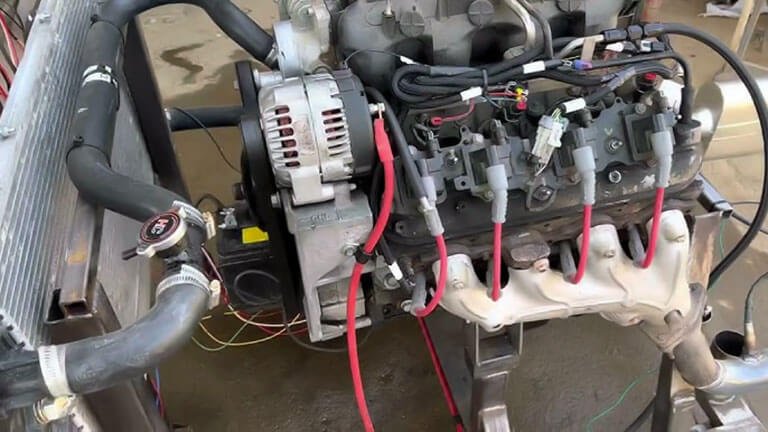Flex Fuel Engine Problems: The Troubleshooting Guide
Flex fuel engine problems often arise from fuel compatibility issues or sensor malfunctions. These can lead to poor performance and reduced efficiency.
Flex fuel engines offer versatility by running on gasoline or ethanol blends. This flexibility can cause unique challenges for vehicle owners. Common issues include fuel system clogs, engine knocking, and check engine lights triggered by sensor errors. Drivers may notice decreased power or lower fuel economy, especially when using high ethanol content fuels.
Maintaining your flex fuel vehicle involves regular inspections and using high-quality fuel. Understanding these problems can help you troubleshoot effectively and maintain optimal performance. Proper care and attention can extend the life of your engine, ensuring a smooth driving experience. Always consult a professional for persistent issues.
Introduction To Flex Fuel Engines

Flex fuel engines offer versatility and efficiency. They can run on gasoline or ethanol blends. This feature provides drivers with more fuel options. Understanding flex fuel engines helps identify potential problems.
What Are Flex Fuel Engines?
Flex fuel engines are specially designed to use multiple types of fuel. They can operate on:
- Regular gasoline
- E85 (85% ethanol, 15% gasoline)
- Any blend of gasoline and ethanol
This flexibility allows drivers to choose based on fuel availability and price. These engines are built with sensors that detect fuel type. They adjust the engine’s performance accordingly.
Benefits And Popularity
Flex fuel engines have gained popularity for several reasons:
- Environmental Impact: Ethanol burns cleaner than gasoline.
- Fuel Cost Savings: Ethanol is often cheaper than gasoline.
- Energy Independence: Reduces reliance on foreign oil.
- Performance: Many flex fuel vehicles perform well on ethanol blends.
Drivers appreciate the choice of fuel. Flex fuel engines support a sustainable future. More automakers are producing flex fuel vehicles.
Common Issues With Flex Fuel Vehicles
Flex fuel vehicles (FFVs) can run on different fuel types. They offer flexibility but can face some common issues. Understanding these problems helps drivers maintain their vehicles better.
Fuel Efficiency Concerns
Many drivers notice a drop in fuel efficiency. This can happen for several reasons:
- Fuel Composition: E85 fuel has less energy than gasoline.
- Engine Tuning: FFVs may not be optimized for E85.
- Driving Habits: Aggressive driving reduces fuel economy.
Drivers might experience:
- Lower miles per gallon (MPG).
- More frequent fuel stops.
Monitoring fuel efficiency helps identify issues early. Regular maintenance keeps the vehicle running smoothly.
Engine Performance Hiccups
Engine performance can vary in flex fuel vehicles. Common symptoms include:
- Rough Idling: The engine may shake or vibrate.
- Power Loss: Acceleration may feel sluggish.
- Check Engine Light: This could indicate multiple issues.
Possible causes for these performance hiccups include:
| Cause | Description |
|---|---|
| Fuel Quality | Poor quality fuel affects engine performance. |
| Sensor Issues | Faulty sensors can send incorrect data to the engine. |
| Fuel Injector Problems | Clogged injectors lead to uneven fuel delivery. |
Regular check-ups and using quality fuel can minimize these problems. Staying alert to engine performance helps prevent larger issues.
Sensor And System Failures
Flex fuel engines rely on various sensors and systems. Failures in these components can lead to significant performance issues. Understanding these problems helps in early detection and repair.
Faulty Fuel Composition Sensor
The fuel composition sensor plays a vital role in flex fuel vehicles. It measures the ratio of ethanol to gasoline. A faulty sensor can cause several issues:
- Incorrect fuel mixture
- Engine misfires
- Reduced fuel efficiency
- Check engine light activation
Common signs of a faulty sensor include:
- Unusual engine sounds
- Poor acceleration
- Frequent stalling
Replacing the sensor can restore engine performance. Regular checks can prevent serious damage.
Problems With The Ecu
The engine control unit (ECU) manages engine functions. It receives data from various sensors. Problems with the ECU can lead to severe issues:
| Problem | Symptoms |
|---|---|
| Corrupted software | Erratic engine behavior |
| Faulty wiring | Check engine light on |
| Overheating | Engine stalling |
Diagnosing ECU problems requires specialized tools. Early detection can save time and repair costs.
Fuel-related Problems
Flex fuel engines can face various fuel-related problems. These issues often stem from the use of ethanol-blended fuels. Understanding these problems helps maintain engine performance.
Ethanol Corrosion And Damage
Ethanol can cause significant damage to engine components. It attracts moisture, leading to corrosion. This corrosion affects parts like:
- Fuel lines
- Injectors
- Fuel pumps
- Carburetors
Corroded components can lead to:
- Decreased fuel efficiency
- Engine misfires
- Increased repair costs
Regular maintenance can help prevent these issues. Check for signs of corrosion frequently.
Fuel System Contamination
Contaminated fuel can damage a flex fuel engine. Common contaminants include:
- Water
- Debris
- Old fuel
Signs of fuel contamination are:
- Stalling
- Difficulty starting
- Rough idling
To prevent contamination:
- Use high-quality fuel
- Store fuel properly
- Replace fuel filters regularly
Regular checks keep the fuel system clean and efficient.
Troubleshooting Flex Fuel Engine Issues
Flex fuel engines can face unique problems. Identifying these issues quickly is vital. Proper troubleshooting helps maintain engine performance and efficiency.
Diagnostic Tools And Techniques
Using the right tools is essential for diagnosing flex fuel engine problems. Here are some common diagnostic tools:
- OBD-II Scanner: Reads error codes from the engine.
- Fuel Pressure Gauge: Checks fuel pressure levels.
- Multimeter: Measures voltage and resistance in electrical components.
- Vacuum Gauge: Assesses engine vacuum and detects leaks.
Techniques for effective troubleshooting include:
- Connect the OBD-II scanner to the vehicle.
- Read and document any error codes.
- Inspect fuel lines for leaks and blockages.
- Check the fuel pump operation and pressure.
- Examine electrical connections for corrosion or damage.
Signs And Symptoms Of Failures
Recognizing the signs of flex fuel engine issues can prevent serious damage. Watch for these symptoms:
| Symptoms | Description |
|---|---|
| Check Engine Light | Illuminates when a problem is detected. |
| Poor Fuel Economy | Reduced efficiency indicates a possible issue. |
| Hard Starting | Difficulty starting can signal fuel delivery issues. |
| Engine Misfires | Uneven engine operation may occur. |
| Unusual Noises | Noises may indicate mechanical problems. |
Early detection of these symptoms can save time and money. Regular checks can help keep your flex fuel engine running smoothly.
Maintenance Tips For Flex Fuel Vehicles
Flex fuel vehicles (FFVs) offer great versatility. They can run on gasoline or E85 ethanol. Regular maintenance is key to keeping them running smoothly. Here are essential tips to ensure your FFV stays in top shape.
Regular Check-ups And Diagnostics
Regular check-ups help catch issues early. Follow these steps for effective diagnostics:
- Schedule routine inspections every 5,000 miles.
- Check the fuel system for leaks or damage.
- Inspect the spark plugs and replace them if needed.
- Monitor the fuel filter. Replace it every 15,000 miles.
- Test the oxygen sensors for proper function.
Regular diagnostics can prevent bigger problems. Keep detailed records of all check-ups. This helps track your vehicle’s health over time.
Best Practices For Fuel Use
Using the right fuel is crucial. Here are some best practices:
| Fuel Type | Recommended Use |
|---|---|
| Gasoline | Use for normal driving conditions. |
| E85 Ethanol | Use for high-performance needs. |
Follow these tips for optimal fuel use:
- Choose high-quality fuels from trusted stations.
- Avoid mixing fuels unless necessary.
- Keep your fuel tank above 1/4 full to avoid sediment.
- Regularly check for fuel contamination.
Proper fuel use enhances engine performance. It also extends the life of your flex fuel vehicle.
Professional Repair Vs. Diy
Flex fuel engines can face various problems. Understanding whether to seek professional help or tackle repairs yourself is crucial. Each option has its advantages and challenges. Knowing when to choose one over the other can save time and money.
When To Seek Professional Help
Some issues require a trained mechanic. Here are signs you need professional help:
- Warning lights: If warning lights stay on, consult a mechanic.
- Strange noises: Unusual sounds may indicate serious problems.
- Fuel performance issues: Poor mileage can signal engine trouble.
- Frequent breakdowns: Regular issues suggest deeper problems.
These situations often need specialized tools and knowledge.
Diy Repairs: Do’s And Don’ts
Many minor repairs can be handled at home. Follow these do’s and don’ts:
| Do’s | Don’ts |
|---|---|
| Check fluid levels regularly. | Ignore unusual engine sounds. |
| Change the fuel filter. | Attempt major repairs without knowledge. |
| Use online tutorials for guidance. | Skip safety precautions. |
| Invest in basic tools. | Neglect regular maintenance. |
Start with small tasks. Building confidence is key. Always prioritize safety. When in doubt, consult a professional.
The Future Of Flex Fuel Technology
The future of flex fuel technology holds great promise. Innovations are emerging to improve efficiency and sustainability. As the world moves towards greener solutions, flex fuel vehicles play a crucial role. These vehicles can run on various fuel blends, helping to reduce dependence on fossil fuels.
Innovations And Improvements
Recent advancements in flex fuel technology focus on enhancing performance. Here are some key innovations:
- Engine Design: New designs boost efficiency and power.
- Fuel Sensors: Advanced sensors adjust fuel mixtures automatically.
- Software Updates: Regular updates optimize engine performance.
Research continues into alternative fuels, such as:
- Ethanol: Derived from corn and sugarcane.
- Biodiesel: Made from vegetable oils and animal fats.
- Methanol: A renewable alcohol fuel.
These fuels can enhance performance and reduce emissions. The future looks bright for flex fuel vehicles.
Environmental Impact And Sustainability
Flex fuel vehicles contribute to a cleaner environment. They reduce greenhouse gas emissions compared to traditional vehicles. Here are some environmental benefits:
| Benefit | Description |
|---|---|
| Lower Emissions | Flex fuels emit fewer pollutants than gasoline. |
| Renewable Resources | Many flex fuels come from sustainable sources. |
| Reduced Carbon Footprint | Using flex fuels helps lower overall carbon emissions. |
As technology advances, the sustainability of flex fuel vehicles improves. More drivers will likely choose these eco-friendly options. This shift can lead to a healthier planet.
Frequently Asked Questions
What Are Common Flex Fuel Engine Issues?
Common issues include poor performance, fuel compatibility problems, and sensor malfunctions affecting engine efficiency.
How To Diagnose Flex Fuel Problems?
Check for error codes using an OBD-II scanner and inspect fuel lines and sensors for damage or leaks.
Can Flex Fuel Engines Run On Regular Gas?
Yes, flex fuel engines can run on regular gasoline, but performance may vary compared to E85 or other ethanol blends.
What Causes Flex Fuel Engine Misfires?
Misfires can be caused by faulty sensors, fuel quality issues, or ignition system problems affecting combustion efficiency.
How To Improve Flex Fuel Engine Performance?
Regular maintenance, using high-quality fuel, and ensuring proper sensor function can enhance flex fuel engine performance.
Conclusion
Flex fuel engines offer versatility, but they can encounter specific issues. Regular maintenance is key to preventing problems. Understanding common symptoms can help you address them early. Always consult a professional for repairs. By staying informed, you can enjoy the benefits of your flex fuel vehicle without unnecessary hassles.






